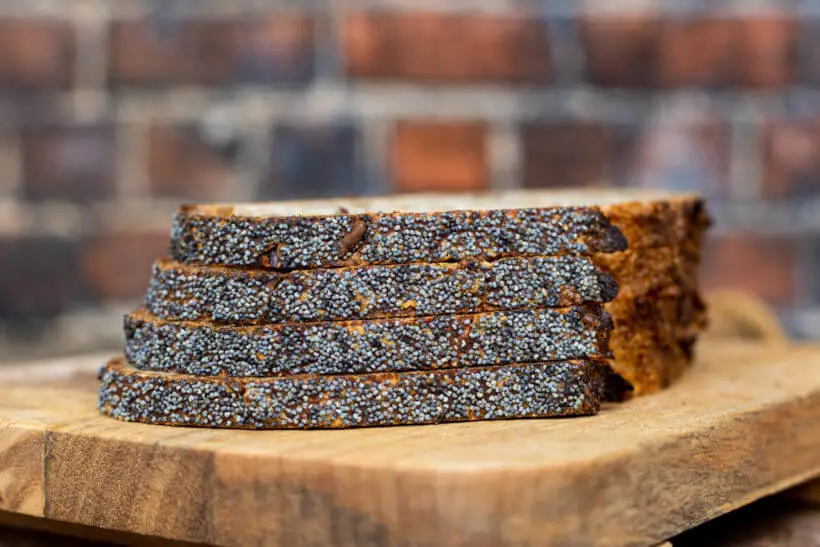You adore seeded bread, but getting those silly seeds incorporated into the dough and getting them to stick is a daunting task, but it’s not that complicated. I’ll give you all the details so that you can make the most gorgeous and tasty sourdough bread with lots of delicious and nutritious seeds. This is my recipe for seeded sourdough bread.
If you are just here for the recipe, you can press the button underneath to be automagically transported to the recipe:
Jump to Recipe Jump to VideoWhat seeds can I put in my bread, and what are the details?
You can use any kind of seed, including but not limited to, flax, sunflower, poppy, chia, pumpkin, and sesame. Other inclusions can be nuts, grains, and legumes.
Toasting the seeds and nuts beforehand can make for a really tasty bread, but raw has its charm too. I will most commonly gravitate towards the toasted variety.
Soaking the seeds, grains, and legumes is a very important part of the process. They will soak up as much water as they can take and when you then add them to your dough they won’t be absorbing water from your dough, making it drier than you had intended.
When using a soaker, it’s very important to drain all the water before using them in the dough, since you might otherwise be raising the hydration in the dough.

The dough in this seeded sourdough bread recipe
Vitals
| Total weight | 1400 grams + seed weight |
| Pre-fermented flour | 9.1% |
| Hydration | 80.0% |
| Yield | 2 small loaves |
The dough
The dough in this seeded sourdough bread is made from 80% bread flour and 20% whole-grain flour. My whole grain is usually dark rye flour, but other flours certainly have their individual charm.
The inoculation is 20%, which is a good middle ground. Fast fermentation but not too fast if your room temperature is around 21°C/70°F. If it’s vastly warmer you may want to lower the inoculation down to 5-10%.
The hydration is 80%, which requires a very absorbent and strong bread flour. In the recipe, I give details on how to lower the hydration. Remember, start low, if it’s a flour you don’t know well.
The amount of salt is 2%, but I will regularly go to 3%. It just makes for a tastier bread. Use the amount your tastebuds and conscience tell you. I wouldn’t go below 1%. Bread without salt does not taste good.
| Weight | Ingredient | Baker's Percentage |
|---|---|---|
| 560g | bread flour | 80% |
| 140g | whole-grain flour | 20% |
| 546g | water | 78% |
| 140g | starter (100% hydration) | 20% |
| 14g | salt | 2% |
If you want to change the quantity, hydration, inoculation, weight, or other things, you can do so here in my Bread Calculator.

The conclusion of this seeded sourdough bread recipe
So for me, the key factors in great seeded sourdough bread are these:
- Even dispersion of seeds in the crumb.
- Seeds that stick to the outside of the bread and don’t just fall off.
This recipe delivers on both of those promises and on top also makes super delicious bread. I hope you till try to make it.

Please share this recipe for seeded sourdough bread on social media
This is my recipe for seeded sourdough bread. If you like the recipe please consider sharing it with like-minded bread lovers on social media.
If you make it and post it on Instagram, please tag me as @foodgeek.dk so I can see it. That would make me very happy.

Seeded Sourdough Bread
Equipment
Ingredients
Dough
- 560 g bread flour
- 140 g whole-grain flour
- 546 g water
- 140 g sourdough starter fed and grown to its peak
- 14 g salt
Soaker
- whatever seeds you like
- water as needed
Instructions
Prepare and soak seeds
- If you want to toast the seeds or nuts, heat your oven to 180°C/360°F, then prepare a parchment-lined baking sheet.
- Then add whatever seeds you would like in the crumb of your bread. There’s not a set amount.whatever seeds you like
- Then when the oven is heated, add the pan to the oven, and set a timer for 10 minutes. If at 10 minutes you want them more toasted, you go right ahead.
- When you've toasted the seeds to your liking, remove them from the oven. Use the parchment paper as a sling to move the seeds to a small bowl.
- Pour water over the seeds. Enough so that they are all hydrated. The amount is not so significant. Leave them for at least 30 minutes to soak.
Mix dough
- Then when you are ready to mix, remove the water from the seeds by pouring everything into a strainer and let it drain completely.
- To a medium bowl add: 560g bread flour, 140g whole-grain flour and 14g salt. Mix it to distribute everything.
- Then add: 140g sourdough starter, fed and grown to its peak, and 546g water.
- You may want to divide the water if you’re unsure what your bread flour can handle. 430g will give you 65% hydration, 469g will give you 70% hydration and 507g will give you 75% hydration.
- Start low if you’re unsure. Add 39 grams of water to bump to 5% more.
- Add all of the drained seeds. Then mix with your hand. In the beginning, make sure you get both the starter and the seeds well distributed.
- Mix until no dry flour remains, then clean up the bowl.
Bulk fermentation
- Leave it to rest covered for an hour to develop the gluten. Then perform three sets of stretch and folds spaced out by 30 minutes.
- Then put the dough in a bulking container, and level the top of the dough.
- Put the dough somewhere warm and let it grow between 25% to 50%.
- I used my proofer set to 30°C/86°F. This speeds up this part of the process. At this temperature, it usually takes me from 2½ to 3 hours to reach 25%.
Divide and shaping
- Then when the dough has finished fermentation, divide the dough into two equally sized pieces.
- Then pre-shape each piece of dough into a light ball.
- Let them rest on the counter for 20 minutes to relax the gluten, which will make it easier to finish the shaping.
- Prepare a dishtowel with the seeds you want to put on the outside of the bread. Put a good layer of seeds on the dishtowel. If you aren’t generous, you won’t get that luscious look.
- Shape the dough balls into whatever shape you like. Watch the video to see how to shape a boule and a bâtard.
- Mist the top of the dough with a bit of water. Then flip the loaf onto the seeds.
- Let the side hit the seeds first, then roll it to the other side. Roll it around in the seeds a bit to get even coverage.
- Lift the dough so that each end also gets covered.
- Grab your banneton, and lift the dough into the banneton.
- Tighten the dough in the banneton. Watch the video to see how.
- Put both loaves in the fridge for at least 8 hours, but up to 48 hours should be fine.
Bake bread
- When it’s time to bake, heat your oven to 230°C/450°F with a dutch oven inside. Let it heat for 30 minutes after the oven comes up to temperature.
- Once the oven is hot, grab a loaf out of the fridge.
- Dust the bottom with rice flour to help it slide easily off the peel, then flip it onto the peel.
- Score the dough, take the lid off the dutch oven, and put the dough inside.
- Put the lid back on, and bake for 25 minutes.
- Just before the 25 minutes are up, prepare the other loaf, like before.
- Take out the first bread and put it beside the dutch oven, then grab the other loaf and put it into the dutch oven.
- Put the lid on, and then bake it for 25 minutes.
- Then grab the first loaf out of the oven, and put it on a wire rack.
- Remove the top of the dutch oven and bake for 25 minutes more.
- Then take out the other loaf, put it on a wire rack and let both loaves cool down to room temperature.











Hi Sune! I watch all your videos and have learned so much from them. I would like to know when using your sourdough recipes (especially the stand mixer one and your seeded breads) if you can use all bread flour instead of a mix of bread flour and whole grain flour. Would I need to lower the hydration? I’m in Canada and we have strong flour, 13.2% protein. Always looking forward to your next video. 🙂
You can but you should be aware that the dough will be more slack. You may want to lower the hydration. 🙂
Hi
Does the 2 1/2 – 3 hour proofing time that you say your dough takes to reach 25% rise include the time you did the stretch and folds or just the time after you placed the dough in the proofer @ 30 deg. ?
Many thanks
Tricia